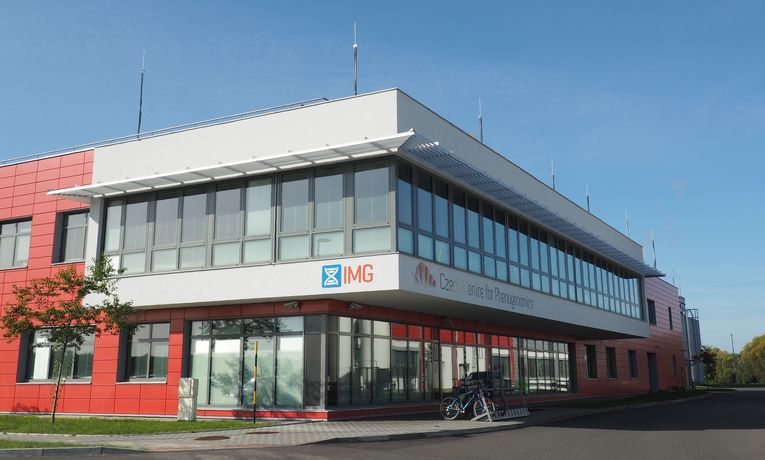About the Czech Centre for Phenogenomics
The Czech Centre for Phenogenomics is a large research infrastructure unique in combining genetic engineering capabilities, advanced phenotyping and imaging modalities, specific pathogen free (SPF) animal housing and husbandry, as well as cryopreservation and archiving, all in one central location – at BIOCEV campus. This concentration of specialized infrastructure and expertise provides a unique and valuable resource for the biomedical and biotechnology research community.

Genetically modified mouse models have become a key tool in basic and biomedical research. The ability to engineer the mouse genome has greatly transformed biomedical research in the last decade. Crucial for this technology is the ability to control the expression of genes of interest. It is possible to increase or decrease gene expression, or eliminate the expression of a gene completely. Transgenic and gene knockout/knockin technologies have become important experimental tools for assigning functions to genes at the level of whole complexity of organism, creating models of genetic disorders, evaluating effects drugs and toxins, thus helping to answer fundamental issues in basic and applied research.
The Czech Centre for Phenogenomics (CCP), through its membership in INFRAFRONTIER and IMPC, is a partner in a collective global network that aims to comprehensively and systematically analyze the effect of loss of function gene mutations in mice. The goal is to produce a comprehensive ‘encyclopedia‘ of gene function, that will help identify causative factors of human diseases as well as novel targets for therapeutic intervention. Through the adoption of standardized procedures and pipelines, and the usage of quality control measures and cross-validation, our shared goal is to produce high-quality data that will not only function as a scientific reference catalog, but will also enable comprehensive meta-analyses that could uncover otherwise hidden disease relationships and functional interactions. By focusing expertise and resources and coordinating our efforts to avoid redundant work, we will help achieve these goals in a more cost-effective manner.
The CCP has planned for its phenotyping capabilities to accommodate both mouse and rat disease models. Although the mouse remains the most cost-effective choice for comprehensive phenotyping, the rat remains a better model for a number of human conditions, including cardiovascular disease, diabetes and behavioral disorders. Through the generation and focused phenotyping of prospective rat models, where gene targets have been identified through the systematic mouse phenotyping effort, we focus our complementary analyses to conditions where the larger size and higher cognitive function of the rat is advantageous for more complex and accurate physiological assessments.
Organizational Structure
The daily operations of CCP are directed by the advisory management board (past executive board) consisting of the executive director of the centre, the heads or deputy heads of respective modules and the scientific director. The director and the board use dedicated project management office with a group of administrators to handle all administrative and managerial tasks. Advisory committees provides invaluable suggestions to the board.
Transgenic and Archiving Module
TAM has established a comprehensive technology portfolio for rodent model generation that is fully comparable with any world-class facility in this specific area. CCP has established routine use of technologies of TALEN and CRISPR/Cas9 assisted gene targeting and genome editing to substantially improve our services in custom-tailored targeting projects saving cost and time. Other technologies provided by TAM include embryonic stem (ES) cell derivation and manipulation, development of targeting strategies and tools, generation of transgenic animals including conditional knock-out and knock-in models, genotyping, cryo-archiving, export/import/distribution, consultancy support, and administrative support (GMO licenses).
Phenotyping Module
The technologies used in the Phenotyping module constitute a whole compendium for examining major physiological systems of the animal body (biochemisty, metabolism, behavior, hearing etc) and enable collection of almost 600 parameters for each phenotyped animal. The portfolio of services and parameters is continually developing. Besides the basic phenotyping tests, CCP provides also secondary tests (challenges), which could be tailored according to the users’ needs. In addition to the service to academic users, CCP provides a contract research as a service. CCP has also established the GLP (good laboratory praxis) mode to serve companies that wish to perform pre-clinical studies in our centre (currently for histopathology and biochemistry unit).
Animal Facility Module
CCP has one of the most progressive animal facilities in Europe regarding logistics, versatility, and demand for animal health. AFM service provides mainly breeding and housing under SPF conditions, health monitoring, biopsies, administration service for import/export of rodent lines, GMO (gene-modified organism), and further administration/transportation. Technologies employed include housing/breeding animals in individually ventilated cages (IVC) and digitally ventilated cages (DVG), giving CCP a very effective way of breeding, and monitoring of animals. CCP operates in a mode of barrier system using a one-way flow of material and animals, a health monitoring system, and advanced software-assisted management of animal facility operations.